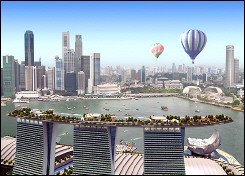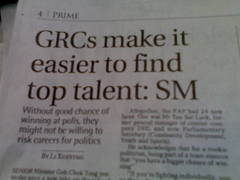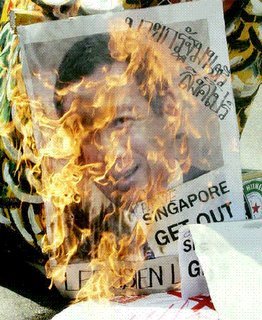Fengshui masters think the Marina Bay Casino's design is a disaster.
The casino-resort at Marina Bay, which will be built on a 50.9-acre waterfront site near the financial district, is likely to cost more than 5 billion Singapore dollars ($3.16 billion), Singapore's Deputy Prime Minister S. Jayakumar told a news conference on Friday 26 May 2006. Las Vegas Sands Corp., owner of The Venetian in Nevada, won a hotly contested license to build Singapore's first casino, which could be the world's costliest casino resort project by the time it opens in 2009. Currently, the world's most expensive casino is the $2.7 billion Wynn Las Vegas that was completed late last year.

The design of the Marina Bay integrated resort is a talking point - especially the 50-storey-high sky park.
The 1ha sky park, larger than two football fields, is one of the most prominent features of the $5 billion resort, which Las Vegas Sands won the bid to build. Linking the tops of three 50-storey hotel towers, the park overlooks the museum, retail and convention spaces and boasts a 360-degree view of the city and the Singapore Strait.
United States-based architect Moshe Safdie designed the resort. He said the greenery at the summit fits Singapore's image as a 'garden city'. The Sands claimed they consulted a fengshui master, but said he was out of town and could not be contacted for comment.
But those interviewed by the local press were not enthusiastic about the design.
Geomancer Victor Li, who has worked with The Raffles Hotel and The Grand Hyatt Singapore, said: "On their own, the three tall buildings look like three ancestral tablets and, with the sky garden, it looks like a broken flyover, with 'neither head nor tail'." He said the Mandarin phrase 'neither head nor tail' has a negative connotation, usually used to describe things that are incomplete and imperfect.
The flatness of the rooftop is another problem.
Master Tan Khoon Yong of Way Onnet Group said it resembles a blade that will affect all buildings surrounding the IR, especially the Swissotel Stamford. "Also, because the rooftop is flat, it restricts the development and growth for the IR," he said.
While geomancer Adelina Pang has no problem with the flat roof, she warned that the garden should not have ponds or water features, because this would symbolise a drowning building.
Out of the 40 people interviewed by The Sunday Times, 22 were impressed by the design, while 18 disliked it.
Ms Loke Mei En, 33, a hedge fund manager, said: "It looks embarrassing. The design is haphazardly put together. It's an aberration on our waterfront."
Others liken the towers to 'joss-sticks' and a 'glorified factory'.
Geomancer Gwee Kim Woon says the buildings are positioned in a shape of a bat. The Mandarin word for 'bat' sounds similar to the Mandarin word for luck, so bats are often associated with luck.
As for the lotus-shaped Art- Science museum, people from both camps supported the idea of a bloom along the waterfront. Architect John Ting said: "To us in Asia, the lotus is providential and if you know how to capitalise on the concept of a lotus, it can be iconic."
But architect Tay Kheng Soon feels the project might be too striking for its own good. "Because it is so outstanding, it is likely to be mistaken as the icon of Singapore. No self-respecting city has a casino as its icon."
Master Chong Swan Lek, 66, commenting on the negative remarks, said it is not a geomancer's job "to tell the architect what to do". His input to the Sands project, however, had the designers splitting one original hotel block into three to let the
qi (wind) through. Asked if geomancy could reduce gambling's social ills, he said "You would have to tighten the law".
On the gaps, which critics say are wind tunnels that bring bad luck to the financial district:
Master Chong: We split them so that the
qi (wind) could pass through. The Swissotel does not even face the IR. It faces Maybank, the mouth of the Singapore River, not the lagoon. The IR actually becomes the
kao san (backer). They got it wrong.
The pools in the garden:
Master Chong: The garden has water and plants, like a mountain. We have water, and the water flows to the MICE (meetings, incentive travel, conventions, exhibitions) business.
50-storey Sky Park critics claim looks like a broken flyover and a blade cutting into the fortune of surrounding buildings:
Master Chong: It's like a scholar's hat, meaning the IR will bring new learning to Singapore.
The three hotel towers that look like three ancestral tablets:
Master Chong: You look properly, they are three warriors standing a foot apart. They are guarding the gaeway to Singapore. Tablets are are straight up, these are curved.
On the three domes:
Master Chong: They are like three coins. In fengshui, when a household has problems, you give them three coins. They ward off evil and bring prosperity.
Lotus shaped ArtScience Museum:
Master Chong: Its five fingers complements the Esplanade. Water flows in and is recycled. Money flows into the casino and back to Singapore, so it won't flow out into Batam and Bintan.
 Their role is not just to ensure minorities are adequately represented in Parliament, he said. They also contribute to Singapore's political stability, by 'helping us to recruit younger and capable candidates with the potential to become ministers'.
Their role is not just to ensure minorities are adequately represented in Parliament, he said. They also contribute to Singapore's political stability, by 'helping us to recruit younger and capable candidates with the potential to become ministers'. The design of the Marina Bay integrated resort is a talking point - especially the 50-storey-high sky park.
The design of the Marina Bay integrated resort is a talking point - especially the 50-storey-high sky park.  Hefty pay raises awarded in July 2000 to what were already some of the highest-paid government officials in the world sparked a rare display of public indignation, with Singaporeans criticizing the move on the Internet and even in the pro-government media.
Hefty pay raises awarded in July 2000 to what were already some of the highest-paid government officials in the world sparked a rare display of public indignation, with Singaporeans criticizing the move on the Internet and even in the pro-government media. 